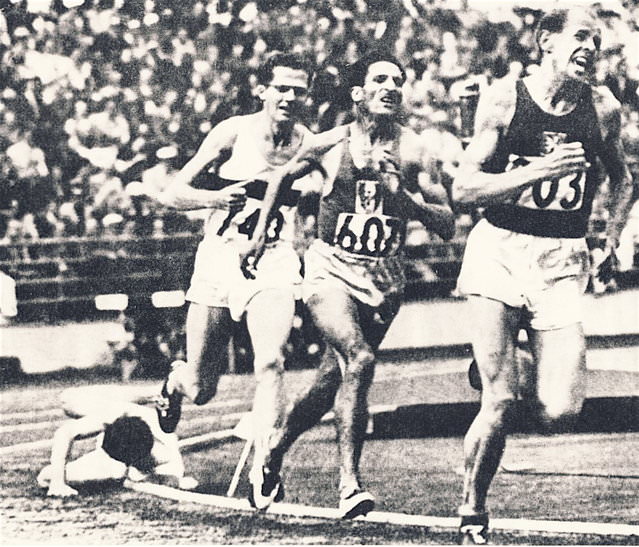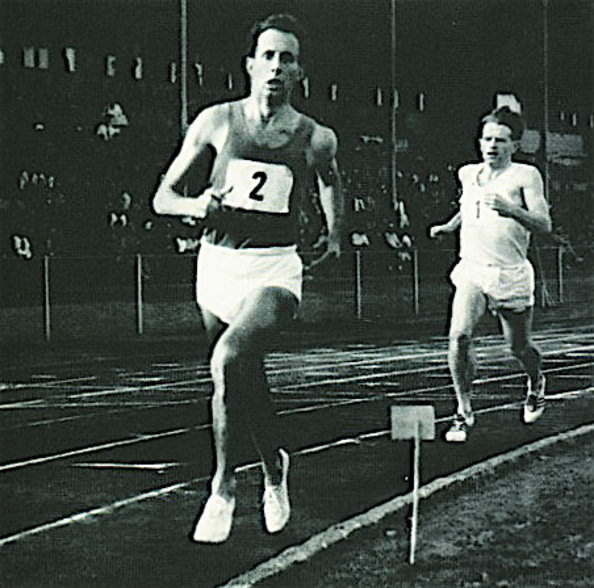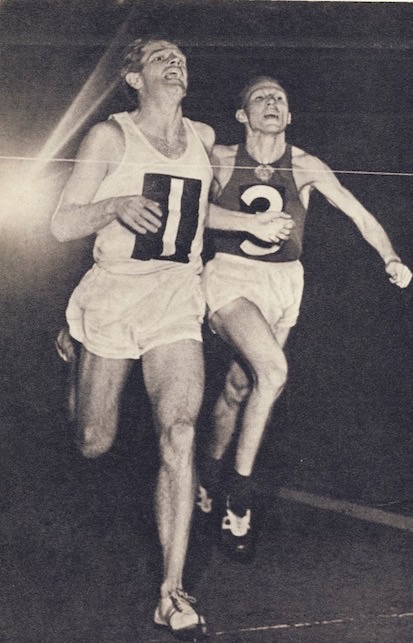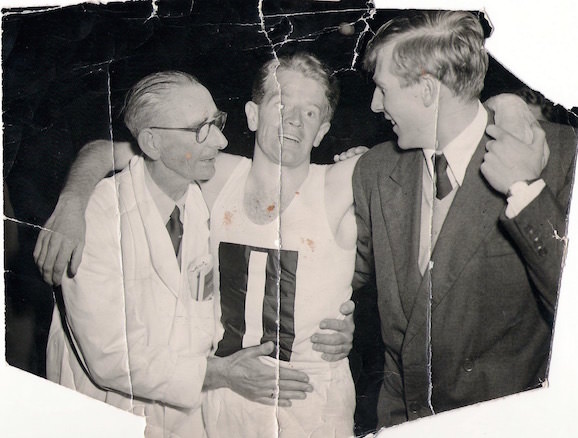CHRIS CHATAWAY
1931-2014
Not quite as talented as Roger Bannister, the cigarette-smoking Chris Chataway relied heavily on his exceptional determination to become one of the most respected runners of his generation. While the general public remembers him as the main pacemaker for the first four-minute mile, the more informed remember him for his epic 5,000 victory over Vladimir Kuts in a world-record time. “I beat Vladimir Kuts and helped Roger Bannister to break the four-minute mile,” he said years later. “In sport, it is stories, not statistics, that matter.” (The Pacemaker, No. 93, 2003).
Red-haired Chataway, known as the Red Fox, first attracted attention with his desperate and flamboyant attempt to win the 1952 Olympic 5,000 final. He had risen to the top quickly after starting his competitive career at Oxford University. He ran a Junior record for the Mile in 1950 with 4:15.6. The next year he was second in the AAA Three Miles and earned his first international vest. Then in 1952 he led the Olympic 5,000 final into the last bend. As the cliché goes, it was a meteoric rise.
Chataway benefitted greatly from the coaching of Austrian Franz Stampfl. Stampfl was an early user of interval training. With his friend Chris Brasher, Chataway trained hard on the track under Stampfl’s supervision. The Austrian coach managed to help Chataway reach international level on the minimum of training.
 |
| 1952 Olympic 5,000: Chataway falls on the last bend. |
The 1952 Olympic final (See Great Races #7) gave a clear demonstration of the Chataway’s competitive flair. Although lacking international experience, he ran the Olympic final as though he was going to win. His mind was in charge; it was up to his body to carry out the plan. Judging by his times up to the Games, he should not have been up with the leaders at the bell. But he was—and he even took charge of the race on the last lap. Rushing into the lead on the back straight, he led to the crown of the last bend. At this point three runners (Zatopek, Mimoun and Schade) attempted to pass him simultaneously. With four runners virtually shoulder to shoulder and with Chataway on the inside, he was pushed towards the kerb, forcing him to step off the track and then fall. He lost about ten seconds through his fall, but he still ran his seasonal best time (14:18), which was about 12 seconds better than his Three-Mile equivalent at that time. “I ought to have gone later,” Chataway said. “I ought to have waited until the final straight. I’m sure I could have got a place.” (Track Stats, Aug. 2005)
Chataway first appeared in the record books in 1953 when he was part of the British 4xMile relay team which broke the world record with 16:41. His best Mile time for this year was 4:08.4. He did nothing in that year to suggest that he was ready for four remarkable performances in 1954.
 |
| Chataway drops back after setting up John Landy for his 3:58.0 Mile WR. |
First, in May, he paced Roger Bannister to the first four-minute Mile, taking over after two laps and leading until the back straight of the fourth. "It was amateurism's last hurrah," he said many years later. "Roger and our group were the last generation who were lucky enough just to be at the top of the sport while having it only as a recreation. A very serious recreation to be sure -- we worked hard at it. But we had other work as well." (Glenn Frankel, Washington Post, May 2, 2004) A few weeks later, in Helsinki, Chataway made the pace for another Mile WR, this time helping Australian John Landy to a 3:58 clocking.
Second, in July, he won the Three Miles in the Empire Games with a time of 13:35.2. He beat his arch-rival Freddie Green with an unanswerable sprint with 250 to go to win his only gold medal in a major games.
Third, in August, he won a silver in the European 5,000. He had tailed Zatopek throughout the race, mistakenly believing the Czech was the man to beat and underestimating the new Soviet star Vladimir Kuts. “I’d never heard of Kuts,” he recounted later to David Thurlow (Track Stats, Aug. 2005) Kuts escaped from the field early in the race to win the gold.
 |
|
Chataway's greatest race: he beats Kuts in world-record time. |
Fourth, in October, he ran his greatest race. The occasion was an evening meeting under spotlights (not floodlights) against the USSR. In this 5,000 race he again ran against Kuts. His European experience told him that he had to stick to the Russian no matter what. He managed to do this (See Great Races #10), and still find enough of a sprint to edge past his rival. "It was the most extravagant race I have ever run," Chataway said when it was over. "Each time he sprinted I thought it was for the last time. But it wasn't. I had no idea he was so difficult to beat." (Sports Illustrated Oct. 25, 1954) Chataway not only beat the European champion but also set a world record of 13:51.6. The race was seen across Europe on the newly established Eurovision network. The story goes that at the Dorchester reception after his victory, Chataway, a recently appointed Guinness executive, shocked the Russians a second time by lighting up a huge cigar.
Chataway had another good year in 1955. He ran a world-record Three Miles (13:23.2) and broke the four-minute mile barrier with 3:59.8. But the 1955 world leaders—Iharos and Kuts—were running world records well beyond Chataway’s times. Still, with his great competitive ability, he had reason to believe he had a good chance of an Olympic medal in Melbourne.
 |
|
After beating Kuts, Chataway is supported by Mickey Mays and Roger Bannister. |
It was time to retire. Chataway was just as successful off the track. In 1955, he had become the first newsreader on Independent Television. Then he entered politics, serving both as an MP from 1959 to 1966 and from 1970 to 1974 and as Minister for Industrial Development. After 14 years in banking, he made his mark in the aviation industry, becoming Chairman of the Civil Aviation Authority.The Melbourne 5,000 (Great Races #11) had him facing Kuts yet again. Although Chataway had a good time for the year (13:59.6), Kuts’s was 17 seconds faster. And Gordon Pirie had just set a new 5,000 WR some 23 seconds faster than Chataway. Still, no one was ignoring Chataway’s competitive ability. He was there to win and didn’t want to work as a team against Kuts with team-mates Ibbotson and Pirie. As it turned out, Chataway was to have a decisive effect on the race—but in a negative way. When Kuts was churning out a fast pace to kill the finishing kicks of the faster Brits, Pirie and Chataway took turns in hanging on to the Russian. At a crucial point when Chataway was second, he suddenly got stomach cramps and dropped back. In a few crucial seconds Kuts had escaped the British trio; the race was won. An ailing Chataway dropped back to 11th.
Later in life, Chataway rediscovered running and quit smoking. He was still running in his seventies. Fifty years earlier in his five-year international career, he had contributed to some of the great moments in track history. He will never be forgotten. 
3 Comments